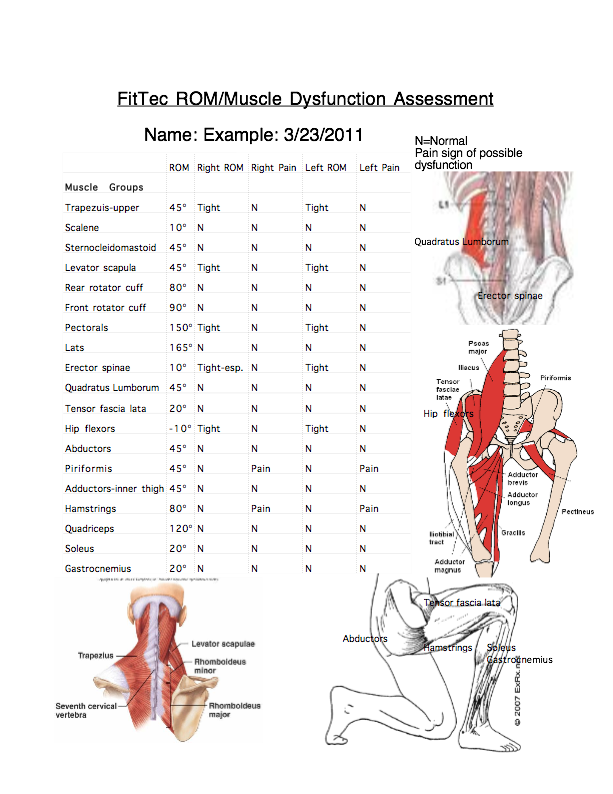Flexibility/Posture Assessments

Normal range of motion (flexibility) and proper posture are essential to the prevention of disorders of the musculoskeletal system. Musculoskeletal disorders occur overtime (overuse or improper use) as well as from a single instance (fall or a slip) in all aspects of life, including the workplace and in sports.
Normal range of motion (flexibility) and proper posture is essential to the workplace and sports.
Assessments only take 10-15 minutes and can be done in loose street clothes.
It can save you from having a host or problems now and years from now.
Caveat: Being hyperflexible can be as bad as being hypoflexible. It is more important to be balanced.
Why is normal flexibility important?
Many don’t stretch, thinking there is no benefit.
Some exercise scientist have suggested not to stretch.
Disregarding stretching may lead to a host of problems that may occur from one instance such as a slip, but more often builds up overtime from overuse.
Flexibility refers to ability of the joints to move through their full range of motion (ROM), which is often enhanced by engaging in a stretching program.
One reason flexibility is important is that it keeps the body in balance.
If the body has areas that are too tight, it finds ways to compensate for that tightness by becoming hypermobile in other areas.
We adjust to the demands we place on our body, good or bad.
If you sit at a desk or drive a car or stand in the same position all day your body may take on the shape of the chair or posture your in, which creates tightness in for those in areas that are stressed. For those in a chair or car the hip flexors, hamstrings, chest muscles become tight, while weakness and lengthening in the upper back muscles occur. These imbalances can result in poor posture, resulting in problems such as back, shoulder, or neck pain.
Another reason flexibility is important is that it allows us the mobility to perform our daily activities effectively and efficiently. Athletes and some laborers need to be able to move freely across different planes of motion to perform efficient movements and to avoid injuries. Older adults need to maintain a healthy range of motion to perform everyday functions like dressing themselves and reaching for things from high shelves.
Lack of proper joint ROM may lead to joint degeneration, muscle adhesions, and other musculoskeletal problems. Recently a study found that flexibility may be a predictor of arterial stiffening, independent of other components of fitness.
Possible benefits of a stretching program
Correct muscle imbalances
Improve joint range of motion
Decrease muscle soreness Decrease both acute and chronic pain
Decrease muscular hypertonicity
Increases connective tissue extensibility
Increases efficiency
Sign up now to have your ROM or in other words Range of Motion and posture assessed.
Email me us at
What will be assessed?
ROM and Pain (possible sign of dysfunction) will be measured.
Trapezuis-upper
Scalene
Sternocleidomastoid
Levator scapula
Rear rotator cuff
Front rotator cuff
Pectorals
Lats
Low back-erector spinae
IT band-Tensor fascia lata
Hip flexors
Abductors-outer thigh, glute
Piriformis
Adductors-inner thigh
Hamstrings
Quadriceps
Calfs-soleus/gastroc
Why is good posture important?
Tight muscles with their opposing weak muscles can lead to poor posture. By adopting good posture, you can prevent or eliminate low back pain, neck strain and carpal tunnel syndrome. These conditions result from chronic muscle strain caused by holding your body in an unnatural position, and also from overuse, lack of overall condition, and poor work stations. Poor posture also can accelerate wear and tear on your joints, which can then lead to arthritis.
Good posture allows you to use your postural muscles more efficiently because they are in correct alignment. Correct use of the muscles not only relieves pain but also gives you an energy boost because your muscles don't have to strain themselves and your fatigue decreases.
Posture assessment example.

Who will doing the assessments: Chris Morin M.S., M.Ed-Chris has been measuring people range of motion for 25 years. Chris has worked in rehabilitation facilities and taught anatomy and physiology labs at Springfield College. He knows the importance of normal range of motion and proper posture.





